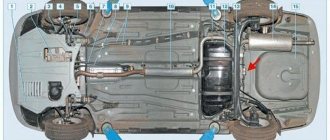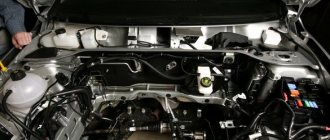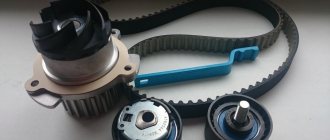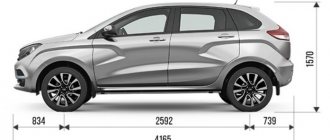For a reliable ride, it is not enough to know how to drive and fill the tank with fuel. All parts and components of the machine are not eternal. To extend their service life, the first thing you need to do is to take care of them on time, prevent possible breakdowns, and eliminate existing faults - preferably strictly according to the maintenance regulations. To adhere to this goal, the following procedure has been created - maintenance of the Lada Vesta car. Moreover, for each vehicle there is a certain time frame for carrying out preventive maintenance. Read the article and your car will be safe and will last a long time!
The regulations for the Lada Vesta indicate the need to replace consumables and diagnose the car every 15,000 km - this is the first maintenance. Behind the scenes, under extreme operating conditions (frequent movements over short distances, stops, low speed limits, transportation of goods), it is recommended to carry out servicing of the Lada Vesta more often, up to 7500 km. If you live in the city or have a trailer, then new oils and filters twice a year will not harm your car.
When and where to undergo the first maintenance on Lada Vesta
According to AvtoVAZ regulations on the Lada Vesta, TO1 must be performed at 15,000 kilometers traveled, or after a year if this distance has not been covered. However, almost all experts recommend undergoing maintenance at 2000 - 5000 km. If you don't do this, dealers may void your warranty. The fact is that new parts are worn in. This leads to increased formation of small metal residues. It is precisely the first kilometers of mileage that are accompanied by this phenomenon, and the shavings walking inside the internal combustion engine and gearbox elements act as an abrasive. This may lead to a quick repair of the part. In addition to oil contamination, at such intermediate maintenance. Service (or maintenance 0) reveals manufacturing defects and, in general, evaluates how the car is running in. Some dealers offer this procedure for free. The cost of work will be from 3 to 5 thousand rubles, depending on the region and service center. But you must remember - if you perform manipulations on the car not from the officials, you risk losing the warranty. Intermediate maintenance is not mandatory; it is not included in the maintenance regulations for the Lada Vesta.
Should I do it or not?
As I already wrote above, this process was mandatory on our cars, I remember driving my VAZ 2114 for sure! Although now on new VAZs (KALINA, GRANT, X-RAY, VESTA) there are the same intervals as on foreign cars, namely 10 - 15,000 km.
Technologies have stepped forward and now you don’t need to go to 1000 - 3000, or even 5000, and as I already said, an intermediate inspection is NOT mandatory. Manufacturers provide resources so that you can travel the first kilometers without any problems.
The main load falls on the oil filter; it contains chips that are formed from the break-in process. It is advisable to remove it from there or change the filter element itself. After all, if this is not done, then throughput drops
What is zero maintenance
Zero maintenance of Lada Vesta is the intermediate maintenance mentioned above. Zero maintenance is carried out on Lada Vesta with a mileage of up to 3000 km. The following work is being carried out:
1)Diagnostics of an internal combustion engine:
- listening to engine operation;
- checking the tightening torque of engine supports;
- inspect the engine connection points for oil or coolant leaks;
- diagnostics of the Lada internal combustion engine using computer equipment;
- if necessary, replace the lubricant and filter element in the engine;
- checking the serviceability of the timing belt and drive belts of the Lada.
2) Diagnostics of transmission elements of Lada Vesta:
- inspection of the torque transmission for accuracy of gear shifting, absence of “left” sounds;
- study of clutch operation (absence of “failures”, noise, “slipping”);
- checking gearbox seals for leaks;
- checking the condition of the clutch cable.
3) Diagnostics of the control system:
- EUR performance assessment;
- analysis of brake efficiency in various situations with a mileage of 3 thousand km;
- inspection of the DOT4 fluid level in the main brake cylinder (if necessary, add working fluids);
- brake line integrity analysis;
- adjusting the brake signal switch;
- diagnostics of the "vacuum";
- checking the parking brake.
4)Diagnostics of electrical equipment:
- prevention of integrity and response to the command of headlights, flashlights, interior lighting and sound alarms of the Lada Vesta;
- checking the functionality of the electronic headlight range control;
- checking the position of the light (if necessary, adjust the optics).
5) Diagnostics of the Lada chassis:
- installation on a vibration stand, listening to the operation of the suspension when driving over uneven surfaces (there should be no knocks, creaks, or “moans”);
- study of the work of the “walker” while moving along a straight path and a rounded one (inspection of constant velocity joints and hub bearings);
- measuring the accuracy of the wheel alignment angle.
The benefits are obvious to me personally
Firstly, no one is immune from manufacturing defects (even if it’s a cool foreign car, the human factor is always present), if it’s not a significant breakdown (as they say), then God bless it, but if it’s a serious breakdown of the chassis or engine, then it’s not very good anymore. You can detect this breakdown at an early stage.
Secondly, you will have all the vehicle's fluids checked. That is, it is possible to identify a problem with hidden defects, for example, the gasket between the “head” and the block itself is faulty, then the liquid will go either into the cylinders or into the manifold.
Thirdly, at “zero” - they will check your suspension camber, which affects tire wear and handling.
Fourthly, testing of all electrical sensors and wiring in general is carried out.
And the most important thing is to change the oil, for which you will need to pay, and for the oil filter too. But you still need to change - SO I READ
I’ll explain why - a new engine is being run-in at the factory, however, with a run of 3000 - 5000 kilometers, many tiny metal particles accumulate in it, which remain due to the lack of wear of the metal in the cylinders. And the lubricant that is poured accumulates these particles.
They are not useful at all, and are even very destructive! With a mileage of 3000 - 5000 km, the running-in mode is completely completed and all the “metal dust” is in the oil. You can, of course, wait for the first maintenance, which will occur at 10,000 - 15,000, but it is better to remove this “dust” earlier, just at the “zero maintenance”, at 5000 – 7500 km. This will allow your engine to last as long as possible, of course if you expect to drive this car for a long time.
List of works during maintenance 1
Maintenance 1 at an official Lada Vesta dealer is scheduled after 15,000 km or a year, if it occurs before these 15 thousand. This is a mandatory procedure under warranty; the mark of completion of Maintenance 1 is entered in the service book. Below is a list of those performed during the first maintenance. maintenance work (here we add a list of maintenance operations 0):
1)Body maintenance:
- cleaning drainage holes in thresholds and doors;
- checking the serviceability of locking devices;
- lubrication of door stops, hinges;
- replacing the Lada cabin filter element;
- assessment of the serviceability of windshield wipers;
- testing heated seats (if equipped);
- testing the rear glass unit defogging device;
- checking the condition of all windows, the functionality of the power windows and the electronic mechanism for turning the side mirrors;
- study of the operation of the air conditioner in different modes.
2) Maintenance of the internal combustion engine and gearbox:
- mandatory replacement of engine oil and oil filter;
- checking the condition of the engine intake and exhaust systems;
- assessment of the tension of the timing belt, drive belts of auxiliary components;
- inspection of the engine cooling system (condition of pipes, radiator, presence of leaks, coolant level in the expansion tank, presence of impurities in it);
- checking the operation of the generator, the generator-battery circuit;
- analysis of the state of the electrolyte in the battery (if it is serviceable);
- inspect fuel lines and hoses for damage and leaks;
- study of the condition of transmission oil and its level.
3)Service of the brake system and steering:
- measuring the amount of play in the Vesta steering rack;
- measuring the residual friction coating of the brake pads (replace if the pads are worn);
- assessment of the integrity of the anthers of the steering tips, racks.
4) Maintenance of the Lada Vesta chassis:
- testing the operation of moving suspension elements;
- checking the condition of chassis parts at the rear and front;
- inspection of CV joint boots, clutch rod, gearbox drive.
The asking price is 3-6 thousand rubles.
Self-service
Since the three-year warranty period had ended, we saw no reason to overpay the dealer for work if we had our own technical center in Tushino. And the consumables purchased at a regular spare parts store made the pockets lighter to a minimum. A canister of “synthetics” Lada Ultra 5W40 (1187 rubles), oil (193 rubles), air (255 rubles) and carbon cabin filters (334 rubles) - that’s the entire set required. Total - less than 2000 rubles for everything. An official TO-5 dealer would cost about 7,000 rubles.
May and early June in Moscow turned out to be unusually hot. Now is the time to check your air conditioner. It hasn’t lost any of its strength; it cools the interior, just like three years ago—almost instantly. We haven’t cleaned the radiators on Vesta yet. And judging by the antifreeze temperature arrow, this is not yet required. The editorial machine has an instrument cluster with old firmware, in which the needle tries to show the real temperature, and not the average 90 degrees. So: it doesn’t fall beyond the usual limit (by eye - about 95–97 degrees) in traffic jams.
List of works during maintenance 2
Every 30,000 km or two years of operation, it is necessary to undergo the Maintenance 2 procedure. The second and subsequent services of the Lada Vesta are mandatory and are carried out every 15 thousand mileage with a report entered in the book. They always include changing the oil, air, cabin and oil filters, and inspecting the condition of Vesta parts. Maintenance No. 2 consists of TO0, TO1 with the addition of a list of works. Therefore, the cost of manipulation is higher - from 6 to 8 thousand rubles.
Maintenance procedures 2, except those mentioned earlier:
- replacing the air filter;
- lubricating battery contacts and cleaning them;
- replacing the cabin filter;
- lubrication of door locks;
- replacing spark plugs;
- checking the wear of tires and wheel rims on the Lada;
- wheel balancing.
Should I do it or not?
As I already wrote above, this process was mandatory on our cars, I remember driving my VAZ 2114 for sure! Although now on new VAZs (KALINA, GRANT, X-RAY, VESTA) there are the same intervals as on foreign cars, namely 10 - 15,000 km.
Technologies have stepped forward and now you don’t need to go to 1000 - 3000, or even 5000, and as I already said, an intermediate inspection is NOT mandatory. Manufacturers provide resources so that you can travel the first kilometers without any problems.
The main load falls on the oil filter; it contains chips that are formed from the break-in process. It is advisable to remove it from there or change the filter element itself. After all, if this is not done, then throughput drops
Russia 24. Latest news from Russia and the world
Lada Vesta: finish of life tests Lada Vesta, First maintenance. First breakdowns. Video version. Mileage 14,600 kilometers.
Repair list for 6
Perhaps the most extensive maintenance occurs at 90,000 km or after 6 years. This is no longer maintenance, but scheduled repairs, which includes:
- changing the engine oil, replacing filters, spark plugs and brake fluid as during maintenance 1, 2 and 3;
- replacement of drive belts and their tensioner rollers when worn;
- replacing antifreeze, flushing with CO.
↑ Filling volumes
The amount of consumable fluids to be replaced depends on the type of engine, gearbox, cooling and heating system.
For motor 11189 (volume in l):
- the need for a lubrication system with a stamped sump is 3.2;
- with a cast crankcase - 4.4;
- for gearboxes 2180 and 2182 – 2.25;
- JHQ – 3.34;
- cooling and heating system requirement – 5.95;
- for a system with preheating – 9.3;
- for the hydraulic drive and brake system – 0.559;
- for the washer reservoir – 4.7;
- expansion tank - 5.75;
- air conditioner - 0.475.
For engine 21129, the difference in volumes lies in the following parameters:
- for a fuel system with a stamped crankcase - 2.9 l;
- with cast – 4.1 l;
- for expansion tank - 5.35 l.
HR16DE engine: lubrication system requires 4 liters; for cooling and heating – 7 l.
Recommended brands of engine oil are Maximum SW-40, MOBIL 3000 SW40, LADA ULTRA 5W-40.
Important! When replacing, mixing different brands of oil, coolant, brake fluid and refrigerant is not allowed.
Subsequent maintenance
After the sixth technical maintenance cycle of preventive maintenance begins anew. The only difference is that at the next 90,000 km (namely 180,000 mileage from the release of Vesta), the replacement of the timing belt with all accompanying rollers is regulated. Please note that it is possible to replace the belt ahead of schedule if signs of wear are detected. The fuel filter is changed only together with the pump at the same 180,000 km in case of failure. The most common maintenance problems that occur!
At the initial stages of break-in, owners may encounter the following malfunctions:
- minor damage to the glass (it is important to undergo maintenance 0, this is often caused by defective windshield wipers);
- burnout of the resonator, its corrosion;
- wear of the engine cooling system hoses;
- rapid failure of glass heaters;
- wear of the rubber parts of the rear anti-roll bars of the Lada;
- malfunction of the lower ball joints;
- multimedia malfunctions.
These are the main “faults” of all modifications of Lada Vesta. We advise you to pay attention to them already at the first service.
Planned maintenance work should not be neglected. And the loss of warranty is not the most important thing. After all, timely maintenance is the prevention of urgent repairs, extending the service life of Lada Vesta components and a guarantee of confidence on the road.
Body
In most cases, Lada Vesta owners have no complaints about the quality of the paintwork, much less the protection of body elements from corrosion. But some of its parts may still not withstand the influence of the external environment, namely:
- Roof, because it has the least protection against rust.
- Front bumper paint that is chipped off by gravel. Fortunately, this element is made of plastic and is not subject to corrosion, but its peeling appearance clearly does not decorate it. The rear bumper coating at the points of contact with the trunk lid also wears out quickly.
Problems with high mileage of a car Rust may appear on metal parts in the engine compartment, because... Due to the loose fit of the hood lid, a lot of dirt and moisture gets there.
Preparation for inspection
The car facilitates the fast and comfortable movement of people and goods. For this, he requires maintaining its purity and impeccability. Before carrying out maintenance on the Lada Grant, you need to take care of the cleanliness of the car. This will allow specialists to spend less time servicing the elements and components of the car.
However, excessive zeal can play a bad joke on the car owner. When the outside of the car is clean, it can be hosed down or automatically pressure washed under the hood. The result will be failed wiring and electromechanical units. Therefore, it is enough to walk under the hood with a damp cloth, and not generously water it in the hope of washing off last year’s oil drips.
Important! If the service involves suspension diagnostics, the car can be washed from below, but, again, without fanaticism, so as not to get on the units under the hood.
The generator, starter and all kinds of sensors do not tolerate moisture.
It is important to remember to disconnect the battery before washing the units under the hood. In most service centers, a service such as a pre-diagnostic wash is mandatory and is included in the cost of Lada maintenance.
Lada granta - 1.6 l (98 hp), 1.6 l (106 hp)
To-15 | To-30 | To-45 | To-60 | To-75 | To-90 | |
Mileage : | 15 000 | 30 000 | 45 000 | 60 000 | 75 000 | 90 000 |
Total cost | ||||||
Job title: | ||||||
Engine oil | ||||||
Oil filter | ||||||
Cabin heater filter element | ||||||
Working fluids, air conditioning system refrigerant - top up (refill) if necessary* | ||||||
Front brake pads - replacement if necessary* | ||||||
The presence of cracks and corrosion of the body, peeling of mastic from the bottom and wheel arches | ||||||
Operation of door and hood locks | ||||||
The condition of the front and rear suspension elements, their rubber and rubber-metal hinges, bushings and cushions, the condition of the steering rod joints and their protective caps, the steering rod joints and their protective caps; protective covers of the steering mechanism, wheel drives, ball pins, condition of the cable ends of the gear shift control drive and their protective covers | ||||||
Total play in steering | ||||||
Tightness of cooling systems, power supply, hydraulic drive of brakes and clutch; condition of hoses, tubes and connections | ||||||
Tightness of seals of components and assemblies | ||||||
Brake fluid level in the hydraulic brake reservoir | ||||||
Coolant level; | ||||||
Condition and tension of the auxiliary drive belt (generator) | ||||||
Condition of wires, reliability of connections and fastening clamps | ||||||
Operation of the generator, lighting, light and sound alarms, electrical equipment and electronic systems according to the indicators of the instrument cluster and other indicators on the instrument panel | ||||||
Absence of non-functional noise and knocking in the engine, transmission components and assemblies | ||||||
Performance of the service and parking brake systems | ||||||
Condition of rims and tires, air pressure in tires | ||||||
Condition of front brake pads and brake discs | ||||||
Presence and correct location of warning labels in the vehicle interior | ||||||
Battery condition | ||||||
Compliance with established standards for the boundaries of light beams of headlights | ||||||
Power steering performance | ||||||
The functionality of the vehicle's electronic systems using instrument panel indicators and the absence of fault codes in the controller's memory | ||||||
Engine air filter | ||||||
Spark plug | ||||||
Rear brake pads - replacement if necessary* | ||||||
Brake fluid | ||||||
Coolant | ||||||
Accessory Drive Belt and Tensioner Pulley | ||||||
Total cost of work | ||||||
* spare parts, working fluids, refrigerant and replacement work (topping up/refilling) are paid additionally by the consumer | ||||||
Cost of spare parts |
Please check with the manager by phone for the cost of maintenance for the 1.6 l (87 hp) internal combustion engine. TO-90 Automall Belgorodsky recommends additionally replacing the timing belt kit.
* Price information contained on this Site is for informational purposes only. The prices indicated are the maximum resale prices (unless otherwise expressly stated in the relevant section of the Site) and may differ from actual prices. The purchase of any service and spare part is carried out in accordance with the terms of the individual sales contract.
Inexpensive. T.O - 3 on Grant with your own hands. part 1
**The information presented on the site regarding recommended retail prices, specifications, standards and technical characteristics is for informational purposes only and under no circumstances constitutes a public offer as defined by the provisions of Article 437 (2) of the Civil Code of the Russian Federation.
Maintenance problems
If any malfunctions occur, you should contact service as soon as possible. By not paying attention to battery failures, you may miss the moment when it can be replaced for free. Then, in addition to the cost of maintenance work, you will also have to pay for replacing the battery. It's better not to make such mistakes.
Grant engines are currently filled with semi-synthetic motor oil at the factory. Since 2013, the features and conditions of maintenance have changed, now you don’t need to change the oil so often (previously, the time to change the technical fluid came after every 3,000 km). If your Granta has a 16-valve engine, then your first maintenance occurs only after 15,000 km. For cars with an 8-valve power unit, it does not require an oil change, but the valves must be adjusted.
During the first service, the Grants can adjust the headlights; if the light beam falls a little lower than expected, check the lambda probe.
In order not to overpay and risk the quality of the lubricant, buy the oil yourself
However, it can be difficult to guess with service in the sense that some enterprising dealers charge inflated fees for such a thing as changing the engine oil, and for the oil itself, which is cheaper to buy in a store and bring to the service station yourself, which is what many Lada owners do.
If possible, achieve the right to be present during service work so as not to disturb the staff, but to see the progress of the work. This is especially important if you live in a small city, where the number of car services is small and there is almost nothing to choose from. It’s easier for residents of large cities; they can take advantage of the advice and reviews of other drivers.
Despite all the riskiness of doing your own maintenance, it can help you save up to half the amount you pay in the end. But you can take it on only with good experience and knowledge. The warranty will not be voided just because you did the repairs yourself. And even the service technician can make a mistake. Another thing is whose mistake will be easier and cheaper to correct.
Please note that the dealer may impose additional services on you. Concentrate only on what is included in the list of necessary works. Moreover, all these procedures do not at all cancel things that are required by regulations. For example, if for some reason you are offered to replace the spark plugs out of turn, and at the next maintenance they need to be updated according to the service book, then you will have to pay for it again.
If you brought any parts and materials for servicing the Lada Granta, they must have a certificate of conformity. Otherwise you will be denied. But if you have the necessary document, no technician has the right, for example, to refuse to fill in the antifreeze you offer. Good luck!
approximate cost
It is impossible to name the exact cost of maintenance, since everything depends on the specific situation and the list of work performed, in addition to the regulated ones. And they will definitely be there.
According to the official AvtoVAZ website, the approximate prices are as follows:
- For TO-0 1600 rubles for an 8-valve internal combustion engine. Other versions of TO-0 do not pass;
- TO-1 will cost 5-6.5 thousand rubles;
- TO-2 costs about 6-7.2 thousand rubles;
- TO-3 from 5 to 6.5 thousand rubles;
- TO-4 from 6 to 7.3 thousand;
- TO-5 about 5-6.5 thousand;
- TO-6 will cost 11.5-12.5 thousand rubles.
The exact cost can be found out after the diagnosis. The craftsmen will draw up a list of necessary work.
Compared to many other cars, maintenance for the Lada Granta is cheap. But even for such a car you have to pay money if the owner is interested in maintaining its technical condition at the proper level.
Source
↑ First maintenance, 15,000 km
The first maintenance after 15,000 km of mileage or 1 year of operation after purchase is carried out in certified centers that have an agreement with official dealers. From this moment on, all work performed is noted in the service book. It contains the necessary list of such works. The car owner needs to check their volume and quality in a timely manner.
Attention! Provided the zero maintenance cycle is completed, there will be fewer problems with maintenance-1. The required scope of work during the initial inspection includes:
The required scope of work during the initial inspection includes:
- changing the oil and filter, cabin air filter, drive belt;
- checking the tightness and level in the cooling system and fuel system;
- condition of brake pads, steering, front and rear suspension;
- operation of the generator, windshield wiper, heated seats, heated rear window, climate control system;
- checking the health of the battery (amount of electrolyte and charge density);
- serviceability of electric windows, mirrors, door locks
- drainage system.
Thus, all major vehicle systems are subject to diagnostics:
- steering;
- chassis;
- brake system;
- transmission;
- accumulator battery;
- electrical equipment;
- tightness of hoses and connections;
- locks.
The car body is checked for corrosion and chips. In operating mode, the engine and gearbox are listened to to determine uncharacteristic noises and knocks.
Detected deviations are eliminated with a corresponding note in the service book.











